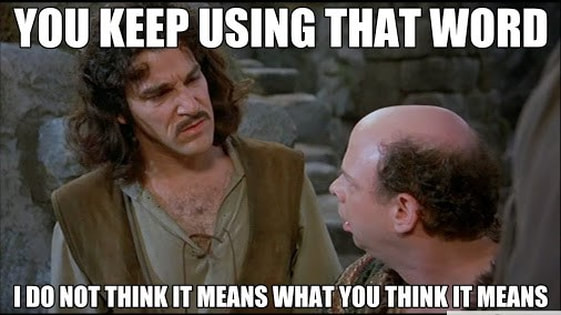 Is what you said, what you said? Is what you said, what you said? We need to be intentional about the messages that you share – it’s not as though everyone waits in the wings for the eloquent words to spill from your lips before they move on with their personal or professional lives, but when you speak as a person in a position of leadership people are listening (even if reluctantly). There is a difference between hearing and understanding, much like there is a distinction between people hearing the content you are delivering and comprehending fully the intent of what you are attempting to communicate (read more about this phenomenon HERE). Content and tone are important when communicating as we always want to present a clear vision of how we can collaborate so that we can conquer. If you have to share some negative information there are means to deliver that message without being negative. For example, if sales are down, there is a difference between, “We are failing and corporate is going to fire us all if we don’t get it right in 30 days!” While this may be true, the likelihood that this inspires anyone to stay on the ship and bail water with you is low. “We have made some positive growth in areas X and Y, where we can be more effective would be to focus our efforts in area Z. I believe by doing so we can improve our numbers for the health of our office and make a positive impression on corporate.” No example is perfect but the role of a person in a position of leadership is to communicate information in a manner to helps the team to grasp the vision and see a clear path to what they can do to help the team improve. Often the tone of delivery is as important as the message. Leaders should not shy away from tough conversations, truth is essential to building trust and accountability in the team. Leaders are looking for ways to inform and inspire their teams at the individual level as well as for the group. Understanding when to pull someone aside to speak to them as an individual and when to address the team as a whole is important, as choosing incorrectly can have consequences. As a general rule, the toughest conversations are best to have in private. Choosing our words includes checking our messages for clarity and consistency with our values. Choosing our tone requires taking a moment to ensure we are presenting pathways to success rather than just focusing on our obstacles. Being honest about where we are is important, but in leading we want to uncover the actions that will bring us to where we need to be. Clarity requires follow up. When the content of a meeting or a message veers into potentially negative territory or the tone could be perceived by some as negative, it is important to follow up with individuals to ensure all parties understand the intent of what was being communicated. Every team member is an individual and even in good teams messages can get mixed or confused. A good leader will both make a habit of following up with individuals as well as have a sense for which messages may be taken differently than intended by others. A great follow up question is to ask, “What are you hearing me say?” or, “From what we have discussed, what are you thinking we should do with that information?” Collaboration from the top down to the bottom up is a sign of health within a team and will go a long way to ensuring everyone is empowered to move the vision forward. If you as a person in a position of leadership are not intentional about the messages you deliver, no matter how small they may seem, you are setting yourself up for trouble (read more an this HERE). Whether you believe a meeting or conversation went well or not, the habit of following up with team members on an individual level will go a long way to building clarity as well as accountability within the team. We want our messages to be clear, but the simple fact remains that not everyone hears or processes information the same way, so the next best thing is to follow up. A few quick questions to keep our messaging on point:
0 Comments
Leave a Reply. |
AuthorThoughts on personal and professional development. Jon Isaacson, The Intentional Restorer, is a contractor, author, and host of The DYOJO Podcast. The goal of The DYOJO is to help growth-minded restoration professionals shorten their DANG learning curve for personal and professional development. You can watch The DYOJO Podcast on YouTube on Thursdays or listen on your favorite podcast platform.
Archives
March 2023
Categories
All
<script type="text/javascript" src="//downloads.mailchimp.com/js/signup-forms/popup/unique-methods/embed.js" data-dojo-config="usePlainJson: true, isDebug: false"></script><script type="text/javascript">window.dojoRequire(["mojo/signup-forms/Loader"], function(L) { L.start({"baseUrl":"mc.us5.list-manage.com","uuid":"b9016446bd3c6a9f0bd835d4e","lid":"83282ffb9e","uniqueMethods":true}) })</script>
|
Jon Isaacson |
Connect. Collaborate. Conquer.
© COPYRIGHT 2015. ALL RIGHTS RESERVED.
|



 RSS Feed
RSS Feed